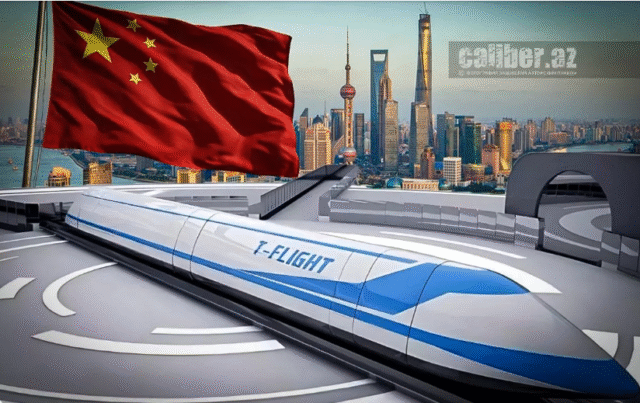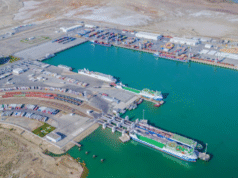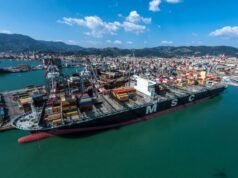A new revolution is unfolding in China—this time, in transportation. The development of a train capable of reaching speeds of 1,000 kilometres per hour could transform the world of logistics. The ability to move shipments across vast distances in mere minutes has the potential to radically reshape both domestic and global markets. Just how far ahead is China compared to the West in transportation technologies?
The floating locomotive
Work continues in China on the T-Flight ultra-high-speed train project, which uses magnetic levitation technology inside a vacuum tube—also known as Hyperloop. The train is expected to reach speeds of up to 1,000 km/h, surpassing the average cruising speed of commercial jet airliners.
The project began in 2022 at a test facility in the city of Datong, Shanxi Province. Initially dismissed as science fiction, the creation of this ultra-fast “millennium” train has since brought together technologies from both the railway and aviation sectors.
Currently, China’s operational magnetic levitation trains in the CR400 series travel at speeds of 350 km/h, with a maximum speed of 400 km/h.
By early 2025, a new model of high-speed train—the CR450—was unveiled. Thanks to a 10% reduction in weight, a 22% decrease in air resistance, improved aerodynamic design, the elimination of resonance, and enhanced thermal insulation, the train’s operational speed has been increased to 400 km/h, with a maximum speed of 450 km/h.

A prototype train using high-temperature superconducting (HTS) magnetic levitation technology, developed by Southwest Jiaotong University, has demonstrated speeds of up to 620 km/h.
For several years now, the Shanghai Transrapid has been running along a 30-kilometre elevated track between downtown Shanghai and Pudong International Airport, reaching speeds of up to 431 km/h.
Today, China’s maglev trains are the fastest commercially operated trains in the world. HTS technology produces no harmful emissions, minimises noise, and offers high safety and low operational costs.
However, the T-Flight project—aimed at reaching speeds of 1,000 km/h—goes beyond the scope of existing technologies.
It’s all about the vacuum tube
High-powered superconducting magnets and HTS (high-temperature superconductivity) technology enable the train to “float” above the tracks without any physical contact, effectively eliminating friction. Yet, as speed increases, so does air resistance. Experts at the China Academy of Railway Sciences (CARS) point out that aerodynamic optimisation was key to raising the CR450’s speed by 50 km/h—but this approach has its physical limits.
The solution: vacuum technology. In 2024, a series of test runs were conducted on a 2-kilometre low-vacuum test track. According to Xinhua, the trials successfully demonstrated controlled navigation, stable levitation, safe braking, and the ability to handle curves.

The vacuum system has also proven effective. The exact speed reached during the latest tests has not been disclosed. However, it is known that during a previous trial in October 2023—conducted without a vacuum environment—the train reached 623 km/h, setting a new world record for maglev trains. In vacuum conditions, T-Flight’s potential speed is significantly higher.
Construction of the vacuum tube is ongoing.
In the future, travel from Beijing to Datong is expected to take just 30 minutes, and the journey to Shanghai only an hour and a half—three times faster than current travel times. Even at such speeds, passengers will have access to the internet thanks to 5G technology.
If realised, the project could seriously challenge aviation on continental routes, offering comparable speeds and a far more reliable timetable. And 1,000 km/h may not be the limit: the CASIC corporation is already working on a train capable of reaching speeds of up to 4,000 km/h.
Interestingly, the speed of 1,000 km/h has already been reached—not by a train, but during tests of an “electromagnetic sled” in Jinan (Shandong Province). In 2022, a project by the Chinese Academy of Sciences in cooperation with local authorities accelerated a cargo weighing over a ton to 1,030 km/h.
The state secret behind China’s success
Meanwhile, similar projects in the US, EU, Japan, and South Korea have yet to surpass speeds of 600 km/h. For example, Japan’s operational Shinkansen trains run at 320 km/h, with plans to increase speeds to 505 km/h by 2027–2037.

The United States has effectively dropped out of the race—Elon Musk’s Hyperloop project and the company implementing it were shut down in 2023.
China’s success is explained by a strong economic foundation and the decisive role of the state. The China Aerospace Science and Industry Corporation (CASIC) is a state-owned organisation. Vacuum train projects receive active support from regional authorities, and construction financing is provided by state banks.
Such projects often do not pay off quickly and are frequently unprofitable at first. However, China can afford large-scale state funding, considering the long-term benefits of developing “bullet trains of the future.”
A global speed revolution
The prospects for this technology are enormous. China already leads the world in the length of high-speed rail networks. According to the 12th Five-Year Plan, the network was supposed to reach 18,000 km by 2020—but in reality, it has exceeded 38,000 km.
Today, many Chinese cities are seeking permission to build vacuum train lines, which is expected to provide a powerful boost to their development.
The implementation of such projects involves technical, environmental, and financial challenges: building vacuum tunnels requires high precision, strict safety standards, and careful consideration of environmental impact. Nevertheless, this mode of transport has a low carbon footprint and can reduce CO2 emissions by 3–4%.
Increasing the speed of passenger and cargo movement can accelerate regional economic development and stimulate urbanisation. Moreover, vacuum trains could become a key component of the Belt and Road Initiative.
By 2030, the construction of the high-speed “Eurasia” corridor is planned, running through Kazakhstan, Russia, and onwards to Europe. Similar lines are also planned for Mongolia, Kyrgyzstan, Uzbekistan, Iran, and Türkiye. The introduction of vacuum technology will radically reshape the logistics landscape and accelerate economic processes across the region.
If the “thousand-kilometre-per-hour” project is successfully realised, China will cement its status as the global leader in high-speed rail technology and the transportation revolution.







